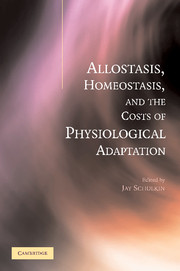Book contents
- Frontmatter
- Dedication
- Contents
- Preface
- Contributors
- Introduction
- 1 Principles of Allostasis: Optimal Design, Predictive Regulation, Pathophysiology, and Rational Therapeutics
- 2 Protective and Damaging Effects of the Mediators of Stress and Adaptation: Allostasis and Allostatic Load
- 3 Merging of the Homeostat Theory with the Concept of Allostatic Load
- 4 Operationalizing Allostatic Load
- 5 Drug Addiction and Allostasis
- 6 Adaptive Fear, Allostasis, and the Pathology of Anxiety and Depression
- 7 A Chronobiological Perspective on Allostasis and Its Application to Shift Work
- 8 Allostatic Load and Life Cycles: Implications for Neuroendocrine Control Mechanisms
- Commentary: Viability as Opposed to Stability: An Evolutionary Perspective on Physiological Regulation
- Index
3 - Merging of the Homeostat Theory with the Concept of Allostatic Load
Published online by Cambridge University Press: 05 February 2015
- Frontmatter
- Dedication
- Contents
- Preface
- Contributors
- Introduction
- 1 Principles of Allostasis: Optimal Design, Predictive Regulation, Pathophysiology, and Rational Therapeutics
- 2 Protective and Damaging Effects of the Mediators of Stress and Adaptation: Allostasis and Allostatic Load
- 3 Merging of the Homeostat Theory with the Concept of Allostatic Load
- 4 Operationalizing Allostatic Load
- 5 Drug Addiction and Allostasis
- 6 Adaptive Fear, Allostasis, and the Pathology of Anxiety and Depression
- 7 A Chronobiological Perspective on Allostasis and Its Application to Shift Work
- 8 Allostatic Load and Life Cycles: Implications for Neuroendocrine Control Mechanisms
- Commentary: Viability as Opposed to Stability: An Evolutionary Perspective on Physiological Regulation
- Index
Summary
CANNON AND “HOMEOSTASIS”
Walter B. Cannon, extending Claude Bernard's concept of the milieu intérieur (Fig. 3.1) taught that coordinated body processes work toward the goal of an ideal set of steady states – “homeostasis.” (Cannon, 1929a, 1929b, 1939). In emergencies, rapid activation of homeostatic systems – especially of what Cannon called the “sympathico-adrenal system” – would preserve the internal environment, by producing compensatory and anticipatory adjustments that would enhance the likelihood of survival.
It is by now clear that activities of daily life, such as meal ingestion, speaking, changing posture, and movement – that is, not only emergencies – are associated with continual alterations in sympathetic nervous system and adrenomedullary hormonal system outflows, maintaining appropriate blood flow to the brain, body temperature, delivery of metabolic fuel to body organs, and so forth. Each of these activities is associated with a somewhat different set of “normal” apparent steady states, directed by the brain and determined by coordinated actions of a variety of effector systems. This principle leads directly to the concept of “allostasis,” as discussed later.
Cannon wrote that not only do activities of physiological systems change to maintain homeostasis but that these alterations also influence behaviors of the organism that in turn contribute to that maintenance. For instance, he noted that animals deprived of salt develop “salt hunger,” and hypoglycemia evokes a hunger for calories (Cannon, 1939). This concept of physiology-induced alterations in motivational states and behavior was subsequently expanded considerably in the research of Curt Richter in the subsequent decades.
SELYE AND “STRESS”
Hans Selye introduced and popularized stress as a medical scientific idea. According to Selye's theory, stress is the nonspecific response of the body to any demand upon it (Selye, 1974). Responses to stressors would have specific and nonspecific components, and Selye referred to only the nonspecific component as “stress.” After removal of specific responses from consideration, a nonspecific syndrome would remain.
- Type
- Chapter
- Information
- Publisher: Cambridge University PressPrint publication year: 2004
- 3
- Cited by

